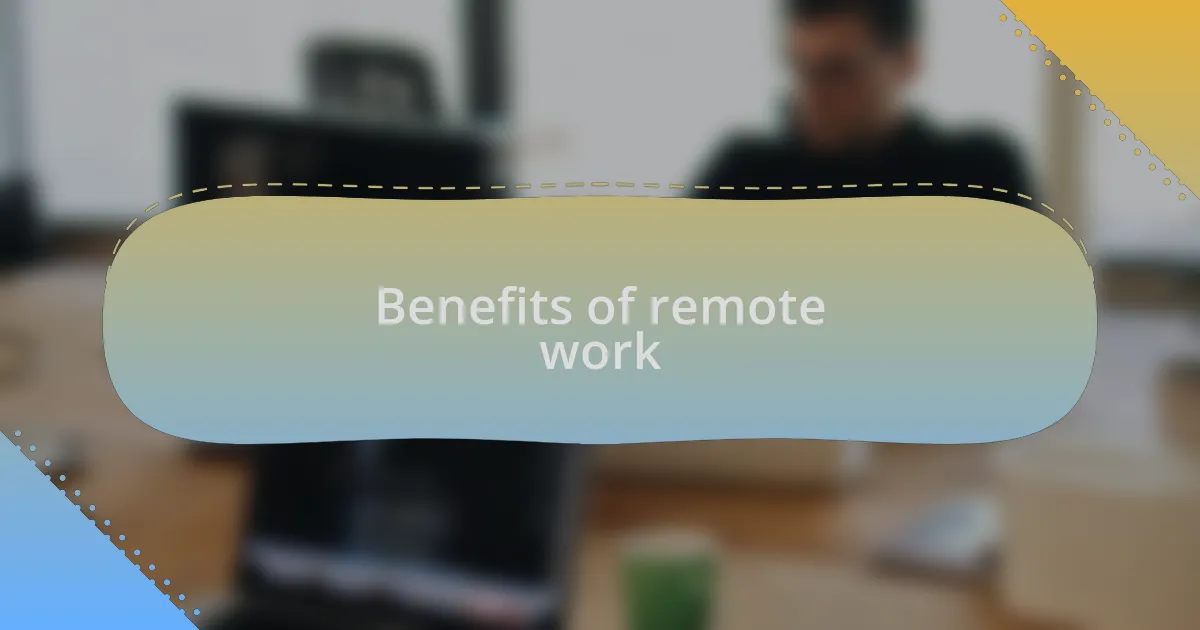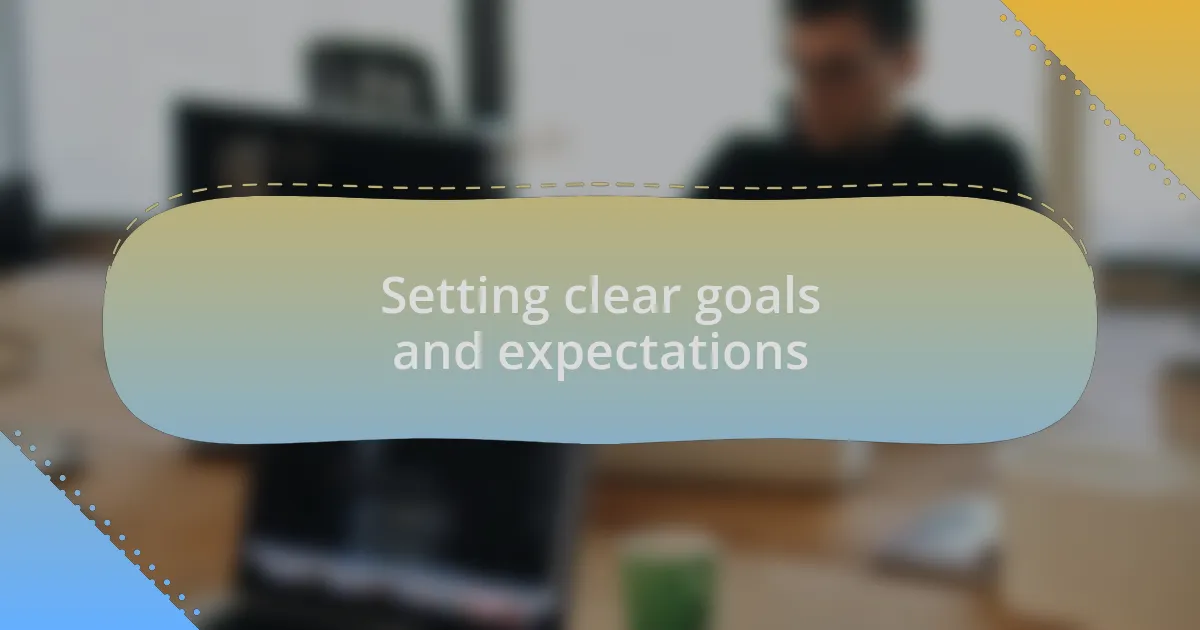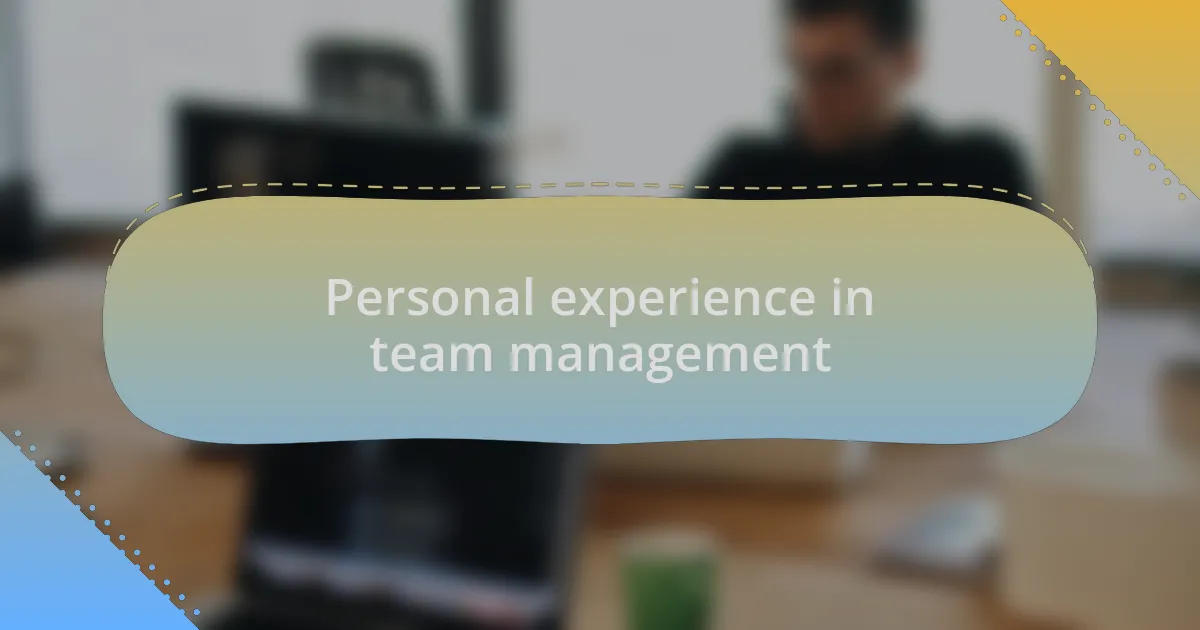Key takeaways:
- Effective communication and building trust are essential for successful remote development teams.
- Flexibility in remote work enhances productivity and work-life balance, benefiting both employees and projects.
- Setting clear goals and regularly revisiting them fosters a sense of purpose and alignment within the team.
- Monitoring progress through tools and regular check-ins encourages accountability and collaboration among team members.

Understanding remote development teams
Remote development teams represent a shift in how we think about collaboration in the tech industry. I remember my first experience managing a remote team, where I quickly learned that effective communication was the cornerstone of our success. At times, I found myself wondering how we could connect and build a strong team culture despite the physical distance.
One key aspect of remote teams is the diversity of talent that can be harnessed. I’ve worked with developers from various cultural backgrounds, and each unique perspective brought something special to our projects. It’s fascinating how remote work can create a melting pot of ideas; have you ever thought about how the blend of different experiences shapes team dynamics?
Trust is another crucial element that I believe makes or breaks remote teams. In the beginning, I struggled with micromanaging out of fear that tasks wouldn’t get done. Over time, I learned to build trust by setting clear expectations and allowing team members the autonomy to thrive. How can we foster this trust in our teams without compromising on accountability? It’s a balancing act that, when executed well, leads to higher morale and productivity.

Benefits of remote work
Remote work offers unparalleled flexibility, allowing team members to design their own schedules. I recall a developer on my team who thrived working late nights, which perfectly matched their peak productivity hours. This autonomy not only improved their work-life balance but also enhanced their overall contribution to our projects. Isn’t it liberating to think that such freedom can lead to better outcomes?
Additionally, remote work often reduces overhead costs for companies, which can be redirected into other areas of the business. I remember my own decision to cut back on office expenses, which opened up opportunities for investing in better tools and technologies for our remote team. Have you ever considered how savings can foster innovation rather than just cutting costs? It’s empowering to realize that a leaner operation can still produce exceptional results.
Moreover, I’ve seen that remote teams often demonstrate increased productivity. It’s interesting to note that when team members work in familiar environments, they tend to feel more comfortable and focused. I’ve even had instances where developers were able to solve complex issues simply because they were in their own space, managing their distractions better. Isn’t it amazing how the right environment can unlock potential?

Tools for managing remote teams
When managing a remote development team, selecting the right tools is crucial. For example, I’ve used Slack extensively for instant communication. It’s not just a messaging app; it creates a vibrant space for updates, questions, and even light-hearted banter. I still remember the time a simple GIF I shared in a project channel sparked laughter and brought the team closer together. Isn’t it remarkable how a little fun can enhance connection?
In collaboration, I find tools like Trello or Asana invaluable for task management. They provide clear visibility on project progress and deadlines, allowing everyone to stay on track. I once had a team member mention how seeing tasks move through stages motivated them to push harder. What’s better than a visual representation of success to fuel your team’s drive?
Video conferencing platforms like Zoom or Microsoft Teams have also transformed our interactions. I distinctly remember a weekly stand-up meeting where we celebrated a major project milestone together. Being able to see each other’s faces and share in the excitement made all the difference. How often do we overlook the power of human connection, even in a digital space? Engaging visuals and direct communication can breathe life into remote collaborations.

Effective communication strategies
Effective communication is the backbone of a successful remote development team. From my experience, I’ve found that setting up regular check-ins can make a significant difference. I still recall a time when our bi-weekly catch-ups helped us identify roadblocks early on, allowing us to tackle issues before they escalated. Have you ever noticed how much smoother projects flow when everyone feels heard?
In addition to scheduled meetings, I like to foster an open-door policy through asynchronous communication channels. Making it clear that team members can reach out whenever they need support creates a culture of collaboration. I once had a team member message me late at night with an idea that ultimately shifted the direction of a project. It just goes to show that communication shouldn’t be confined to office hours; sometimes, the best ideas arise when you least expect them.
To enhance clarity, I prioritize concise and actionable messaging. When sharing updates or feedback, I aim for straightforward language and specific details. I remember receiving a vague update once that left me puzzled. It made me realize that clarity prevents confusion and fosters a more effective exchange of ideas. Isn’t it fascinating how the choice of words can either bridge a gap or widen it?

Setting clear goals and expectations
Setting clear goals and expectations is crucial for any remote development team. I remember a project where we began with vague objectives, and chaos ensued. It taught me that establishing specific, measurable goals at the outset creates a strong foundation. Isn’t it easier to navigate a project when everyone is on the same page?
When I transitioned to setting expectations upfront, I observed a remarkable change in team dynamics. Each member understood not only their tasks but also how their contributions aligned with the larger project vision. One particularly memorable instance was when I introduced a shared document outlining everyone’s roles. It helped clear up confusion and kept everyone motivated, knowing exactly how they fit into the bigger picture.
Moreover, I find that revisiting those goals regularly is equally important. During a recent project, we did a mid-term review, and it was enlightening to see how much progress we had made together. It sparked a renewed energy and focus among the team. Have you experienced that moment when reaffirming expectations ignites an unexpected boost in productivity?

Monitoring progress and performance
Monitoring progress and performance is an integral part of managing a remote development team. I like to use a combination of tools such as Trello and GitHub, which provide transparency on tasks and code contributions. It’s rewarding to see how these tools allow everyone to visualize progress; when a team member marks a task as complete, it creates a little celebration for everyone. Have you ever noticed how small wins can energize a team?
In my experience, regular check-ins are essential. I schedule weekly one-on-ones to discuss challenges and achievements, and I’ve discovered that these conversations foster trust and open communication. Once, a team member opened up about feeling overwhelmed with a deadline, and we were able to reallocate responsibilities, easing the pressure without sacrificing quality. Isn’t it interesting how a simple chat can make such a difference in performance?
Ultimately, I believe that feedback plays a crucial role in monitoring performance. I encourage team members to share constructive critiques and positive notes about each other’s work. After implementing a peer review system, I noticed a shift in morale; it became less about hierarchy and more about collaboration. Isn’t it fascinating how fostering a supportive environment can lead to better outcomes for everyone involved?

Personal experience in team management
Managing a remote development team has taught me the importance of adaptability. Early on, I noticed that not all team members thrived in the same communication style. For instance, I had one developer who preferred detailed written updates, while another excelled during quick video calls. I learned to mix communication methods, ensuring everyone felt comfortable expressing their thoughts. Have you ever had to adjust your style to meet team needs?
Building strong relationships is at the core of my management philosophy. I remember a time when I organized a casual virtual coffee chat to connect on a personal level beyond just work discussions. It was amazing to see how sharing personal stories—like our favorite hobbies or weekend plans—created a sense of camaraderie and trust. I’ve found that these small moments can dissolve barriers and lead to more effective collaboration. Isn’t it heartwarming to see a team transform into a close-knit unit?
In my journey, I’ve come to appreciate the power of celebrating not just victories, but also learning moments. Early in my management career, I was hesitant to address failures openly; however, when I started recognizing them as opportunities, the team flourished. One time, after a challenging project that didn’t meet expectations, we held a retrospective session. Rather than assigning blame, we focused on what we could learn and do differently next time. What was enlightening for me was how the team rallied together, embracing the mindset of growth.